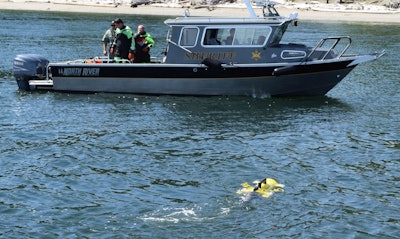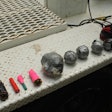 JW Fishers' ROVs can find evidence such as firearms or even bodies under water, protecting law enforcement dive teams from dangerous current and pollution.Photo: JW Fishers
JW Fishers' ROVs can find evidence such as firearms or even bodies under water, protecting law enforcement dive teams from dangerous current and pollution.Photo: JW Fishers
For more than 50 years, JW Fishers has specialized in the design and manufacture of underwater search equipment for police, fire and rescue, commercial, military, and other search applications worldwide.
JW Fishers' diverse product line includes diver-held and boat-towed metal detectors, marine magnetometers, underwater camera systems, ROVs, cable trackers, acoustic pingers, a pinger receiver, sector scan sonars, and side scan sonars. In particular, JWF's sonar systems, ROVs, and its award-winning handheld metal detectors have proven to be very useful in police, military, and fire and rescue operations.
ROVs
The flagship products of the JW Fishers video line are two high-tech, economically priced ROVs: the SeaOtter-2 and the SeaLion-2. These highly maneuverable remote-controlled vehicles each have four motors that provide sufficient power to work in ocean currents with depth ratings of up to 1,000 feet.
The SeaLion-2 boasts even more thrust with a "power boost" feature that provides the ROV with an extra burst of speed in high current situations. The 2,200-lumen LED lighting provides vivid images in low-visibility environments. The high-resolution front and rear color cameras both have pan and tilt capability, providing the topside operator a clear picture of the underwater environment. Weighing less than 45 pounds, the ROV is easily deployed and recovered by a single person.
To fit the varied requirements of public safety agencies and military units, Fishers' ROVs are available with an extensive set of options that allow them to be tailored to specific missions. Options for the system include a manipulator arm, side cameras, and sector scanning sonar (SCAN-650) technology. With a manipulator arm, the ROV can pick up a lightweight object off the bottom or carry an acoustic pinger and drop it on a submerged object. The scanning sonar mounted on the ROV allows the operator to "see" far beyond the range of the camera.
Sonar
Scanning sonar can be used very effectively as a standalone search system. Law enforcement agencies are using scanning sonar in their underwater search operations to find drowning victims, bodies of murder victims or suicidal subjects, sunken vehicles, sunken vessels, and other evidence. One key advantage of scanning sonar is its ability to produce a "picture" of the underwater environment, even in zero visibility. Using this sonar dramatically reduces the exposure time of divers in sometimes frigid or dangerous waters.
One of the reasons for choosing scanning sonar instead of a side scan system is its significantly lower cost, although it is not as effective for searching large areas. This can be a powerful argument for agencies working on a limited budget. Scanning sonar systems require a stationary deployment or mounting on another system; this is often an advantage over the larger towed sonar systems. With towed side scan technology, the towfish must be moving to create an image, whereas the scanning sonar transducer can be held in a fixed position. When searching a lake bottom that is covered with trees or large rocks, it may be difficult if not impossible to tow a sonar system. Lowering the scanning sonar, however, is simple and efficient. Deploying the scanning sonar system on a pole or cable when standing on a solid structure can be a quick and easy way to deploy it.
The sonar software has a host of features that allow the search to be tailored to the needs and preferences of the operator. The size of the search area can be selected and the operator can choose whether to scan the complete area or just a portion of it. A variety of color schemes in 256 shades are available to display the sonar images. There is a choice of step sizes, sweep speeds, and a sizing tool that shows the length and width of the target. High-resolution images are displayed on a topside laptop computer or tablet mounted in the lid of the Sonar Processor Box. Scanned data files are stored on the computer's hard drive along with the boat's GPS position, the time and date, and other pertinent data. Recorded files can be played back at any time, and small file sections and screen shots can even be copied for emailing. The included GPS allows a target's position coordinates to be instantly viewed and automatically stored with the sonar data. Optional boat tracking software shows the path of the boat as it travels over the search area and the width of the scanned area, all overlaid on a nautical chart.
A few of the many public safety units using Fishers' sonar systems are the Beadle County (SD) Office of Emergency Management, the Fall River (MA) Police Department, the Suffolk County (NY) Sheriff's Marine Unit, Union (PA) Fire Company, and the North Carolina Department of Transportation.
Metal Detection
Let's say you are looking for a discarded firearm in a body of water. Once a target area is narrowed and a dive team has been deployed, it's time to use one of Fishers' handheld metal detectors, either the Pulse 8X or the SAR-1 Search and Recovery detector.
The Pulse 8X is JW Fishers' leading underwater metal detector and has been an industry leader for the past 32 years. In 2014, it was named the top underwater metal detector in an independent study performed by the U.S. Department of Homeland Security. The P8X was compared to seven other leading detectors on the market and found to be the most economical, effective, and reliable tool for the job.
The P8X comes with everything needed to search both on land and while submerged to a depth of 200 feet. The unit comes equipped with a land handle and telescopic extension, an underwater handle, two chargers (AC/DC), a land headset, an underwater "bone" phone, and a diver's belt to hip-mount the unit.
The SAR-1 underwater metal detector was introduced in 2017. This detector was purpose-built for law enforcement and other public safety dive teams whose mission sets include locating metallic objects in low visibility environments. The SAR-1 has a streamlined and snareless design with no external wires or cables. These features make the SAR-1 an excellent tool for work in environments containing hazards. The SAR-1's 10 ultra-bright LEDs and sensory (vibration) target indicators make this unit one of a kind.
A few of the many law enforcement teams using Fishers' detectors include: the U.S. Coast Guard, U.S. Border Patrol, Missouri State Water Patrol, the Placer County (CA) Sheriff's Department, the Lowndes County (GA) Sheriff's Department, the Jackson County (WI) Dive Unit, the Detroit Police Underwater Recovery Unit, the Houston Police Dive Team, the New Jersey State Police, the New York State Police, the National Police Dive Squad in New Zealand, the Swedish Coast Guard, Japan's National Police Agency, and the Royal Canadian Mounted Police.
For more information on Fishers' complete line of underwater search equipment go to www.jwfishers.com.
Brian Smith Fisher is the chief operating officer of JW Fishers.

















